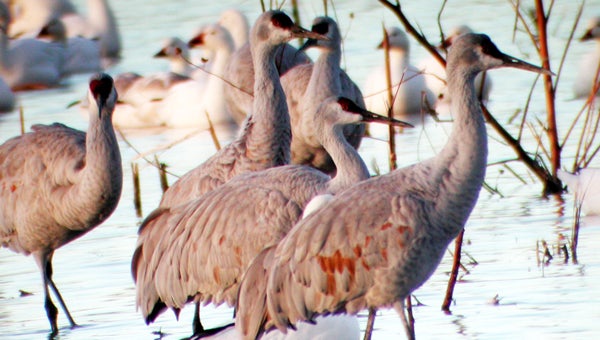Sandhill Cranes rare pleasures in Carolinas
Published 9:10 am Monday, December 3, 2012
Sandhill Cranes are magnificent birds. Standing over 4 feet tall with a 7-foot wing span, they are one of the largest birds in North America.
In several states, such as New Mexico, Tennessee and Nebraska, their winter and migrant concentrations are spectacular, where they are called some of the finest birding sights in the country. Cranes are very primitive birds and fossil remains have been found dating back some 40-60 million years.
Although historically far more diverse and widespread, they are now a small family of birds of 15 species. Asia is now their stronghold with eight species being found there. Two species are found in North America, the abundant Sandhill Crane and the very rare Whooping Crane, which may be the rarest of all of the world’s species of cranes. Four species are found in Africa, including the Wattled and Blue Cranes and both of the Crowned-Cranes, while the last remaining species, the Brolga, is restricted to Australia.
Cranes are unfortunately becoming very rare in many parts of the world due to habitat loss and hunting, although here in North America the picture is a little better. In 1941 the Whooping Crane population had crashed to only 41 birds, and now, with great care and attention, has risen to over 400 individuals. Sandhill Cranes are far more abundant with a population of almost a million birds from California to Tennessee. However, within this large population there are several populations, and many of these are again declining.
Here in the Carolinas, Sandhill Cranes are fairly rare birds, although they are being seen more often every year. While finding one in either North or South Carolina used to be a rarity, small numbers are now annual in several parts of the Carolinas, including here in the western North Carolina mountains.
Sandhill Cranes are omnivorous and eat food items such as frogs, small rodents and insects, as well as vegetable matter, such as bulbs, roots and seeds. The latter is especially important during the winter when many birds feed on spilt grain in agricultural fields. Cranes are also famous for their “dancing,” which is used mainly for display. Both pair members do an elaborate posturing of leaps, bows and turns. This re-establishes the pair bond, especially important as cranes remain as a pair for many years.
Once they arrive back on their breeding grounds in the spring, usually in the far north of the North American continent, the female lays two eggs on a simple mound of vegetation. They hatch in about one month and in about eight weeks can fly for short distances.
Cranes are magnificent birds and to hear a flock of them calling their unusual and distinctive bugling calls as they fly overhead almost brings out a primeval admiration in humans. Maybe we admire their wildness or their beauty or even a combination of both. With all that cranes do for us, it’s important that we protect the wild country that they need to survive.
Simon Thompson has lived in WNC for the past 20 years. He owns and operates his own birding tour company, Ventures Birding Tours. WWW.birdventures.com. He and Chris also own and operate the Asheville Wild Birds Unlimited Store. For more information on any of the birding activities in the area, drop by the store or check his website at www.asheville.wbu.com.


